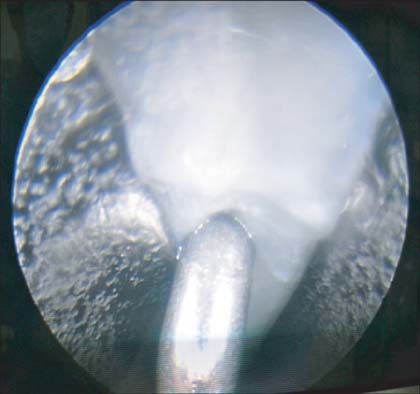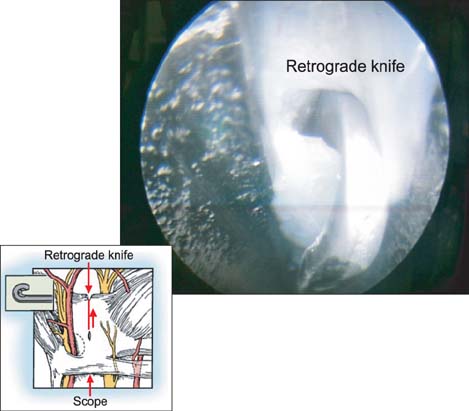Clin Orthop Surg.
2014 Sep;6(3):253-257. 10.4055/cios.2014.6.3.253.
Current Approaches for Carpal Tunnel Syndrome
- Affiliations
-
- 1Department of Orthopaedic Surgery, Kyungpook National University School of Medicine, Daegu, Korea.
- 2Department of Orthopaedic Surgery, Park Hospital, Daegu, Korea.
- 3Department of Orthopaedic Surgery, Asan Medical Center, University of Ulsan College of Medicine, Seoul, Korea. jeonchoi@gmail.com
- KMID: 1794704
- DOI: http://doi.org/10.4055/cios.2014.6.3.253
Abstract
- With advancement in biomechanical and biological research on idiopathic carpal tunnel syndrome, the insight on the pathophysiology of carpal tunnel syndrome has gained much clinical relevance. Open carpal tunnel release is still a gold standard procedure for carpal tunnel syndrome, which has evolved into mini-open procedure with development of new devices. Endoscopic carpal tunnel release has become popular in recent practice of hand surgery with an advantage of early recovery of hand function with minimal morbidity. However, endoscopic carpal tunnel release has its own limitation such as long learning curve with obvious surgical risk reported in the literature. In this review article, various treatment protocols for idiopathic carpal tunnel syndrome are presented with special highlight on endoscopic carpal tunnel release, which is gaining popularity in current practice.
Keyword
Figure
Reference
-
1. Atroshi I, Gummesson C, Johnsson R, Ornstein E, Ranstam J, Rosen I. Prevalence of carpal tunnel syndrome in a general population. JAMA. 1999; 282(2):153–158.2. Piazzini DB, Aprile I, Ferrara PE, et al. A systematic review of conservative treatment of carpal tunnel syndrome. Clin Rehabil. 2007; 21(4):299–314.3. Walker WC, Metzler M, Cifu DX, Swartz Z. Neutral wrist splinting in carpal tunnel syndrome: a comparison of night-only versus full-time wear instructions. Arch Phys Med Rehabil. 2000; 81(4):424–429.4. Scutt N, Rolf CG, Scutt A. Glucocorticoids inhibit tenocyte proliferation and Tendon progenitor cell recruitment. J Orthop Res. 2006; 24(2):173–182.5. Cassuto J, Sinclair R, Bonderovic M. Anti-inflammatory properties of local anesthetics and their present and potential clinical implications. Acta Anaesthesiol Scand. 2006; 50(3):265–282.6. Davies T. Injection with methylprednisolone for carpal tunnel syndrome: study is needed to determine best treatment for this syndrome. BMJ. 2000; 320(7235):646.7. Bland JD. Treatment of carpal tunnel syndrome. Muscle Nerve. 2007; 36(2):167–171.8. Verdugo RJ, Salinas RA, Castillo JL, Cea JG. Surgical versus non-surgical treatment for carpal tunnel syndrome. Cochrane Database Syst Rev. 2008; (4):CD001552.9. Badger SA, O'Donnell ME, Sherigar JM, Connolly P, Spence RA. Open carpal tunnel release: still a safe and effective operation. Ulster Med J. 2008; 77(1):22–24.10. Boya H, Ozcan O, Oztekin HH. Long-term complications of open carpal tunnel release. Muscle Nerve. 2008; 38(5):1443–1446.11. Okutsu I, Ninomiya S, Takatori Y, Ugawa Y. Endoscopic management of carpal tunnel syndrome. Arthroscopy. 1989; 5(1):11–18.12. Chow JC. Endoscopic release of the carpal ligament: a new technique for carpal tunnel syndrome. Arthroscopy. 1989; 5(1):19–24.13. Okutsu I, Ninomiya S, Hamanaka I, Kuroshima N, Inanami H. Measurement of pressure in the carpal canal before and after endoscopic management of carpal tunnel syndrome. J Bone Joint Surg Am. 1989; 71(5):679–683.14. Makowiec RL, Nagle DJ, Chow JC. Outcome of first-time endoscopic carpal tunnel release in a teaching environment. Arthroscopy. 2002; 18(1):27–31.15. Sorensen AM, Dalsgaard J, Hansen TB. Local anaesthesia versus intravenous regional anaesthesia in endoscopic carpal tunnel release: a randomized controlled trial. J Hand Surg Eur Vol. 2013; 38(5):481–484.16. Ip WY, Sweed TA, Fung KK, Tipoe GL, Pun TS. A new technique of single portal endoscopic carpal tunnel release. Tech Hand Up Extrem Surg. 2012; 16(1):27–29.17. Pajardi G, Pegoli L, Pivato G, Zerbinati P. Endoscopic carpal tunnel release: our experience with 12,702 cases. Hand Surg. 2008; 13(1):21–26.18. Hankins CL, Brown MG, Lopez RA, Lee AK, Dang J, Harper RD. A 12-year experience using the Brown two-portal endoscopic procedure of transverse carpal ligament release in 14,722 patients: defining a new paradigm in the treatment of carpal tunnel syndrome. Plast Reconstr Surg. 2007; 120(7):1911–1921.19. Oertel J, Schroeder HW, Gaab MR. Dual-portal endoscopic release of the transverse ligament in carpal tunnel syndrome: results of 411 procedures with special reference to technique, efficacy, and complications. Neurosurgery. 2006; 59(2):333–340.20. Boeckstyns ME, Sorensen AI. Does endoscopic carpal tunnel release have a higher rate of complications than open carpal tunnel release? An analysis of published series. J Hand Surg Br. 1999; 24(1):9–15.21. Mintalucci DJ, Leinberry CF Jr. Open versus endoscopic carpal tunnel release. Orthop Clin North Am. 2012; 43(4):431–437.22. Vasiliadis HS, Xenakis TA, Mitsionis G, Paschos N, Georgoulis A. Endoscopic versus open carpal tunnel release. Arthroscopy. 2010; 26(1):26–33.23. Palmer AK, Toivonen DA. Complications of endoscopic and open carpal tunnel release. J Hand Surg Am. 1999; 24(3):561–565.24. Lindley SG, Kleinert JM. Prevalence of anatomic variations encountered in elective carpal tunnel release. J Hand Surg Am. 2003; 28(5):849–855.25. Werner R, Armstrong TJ, Bir C, Aylard MK. Intracarpal canal pressures: the role of finger, hand, wrist and forearm position. Clin Biomech (Bristol, Avon). 1997; 12(1):44–51.
- Full Text Links
- Actions
-
Cited
- CITED
-
- Close
- Share
- Similar articles
-
- The Current Concepts for the Pathophysiology of Idiopathic Carpal Tunnel Syndrome
- Ultrasound-Guided Nerve Hydrodissection for Carpal Tunnel Syndrome
- Carpal Tunnel Syndrome in Children with Hypogammaglobulinemia: Case Report
- Does Aging Matter? The Efficacy of Carpal Tunnel Release in the Elderly
- The Carpal compression Test for Diagnosing Carpal Tunnel Syndrome





